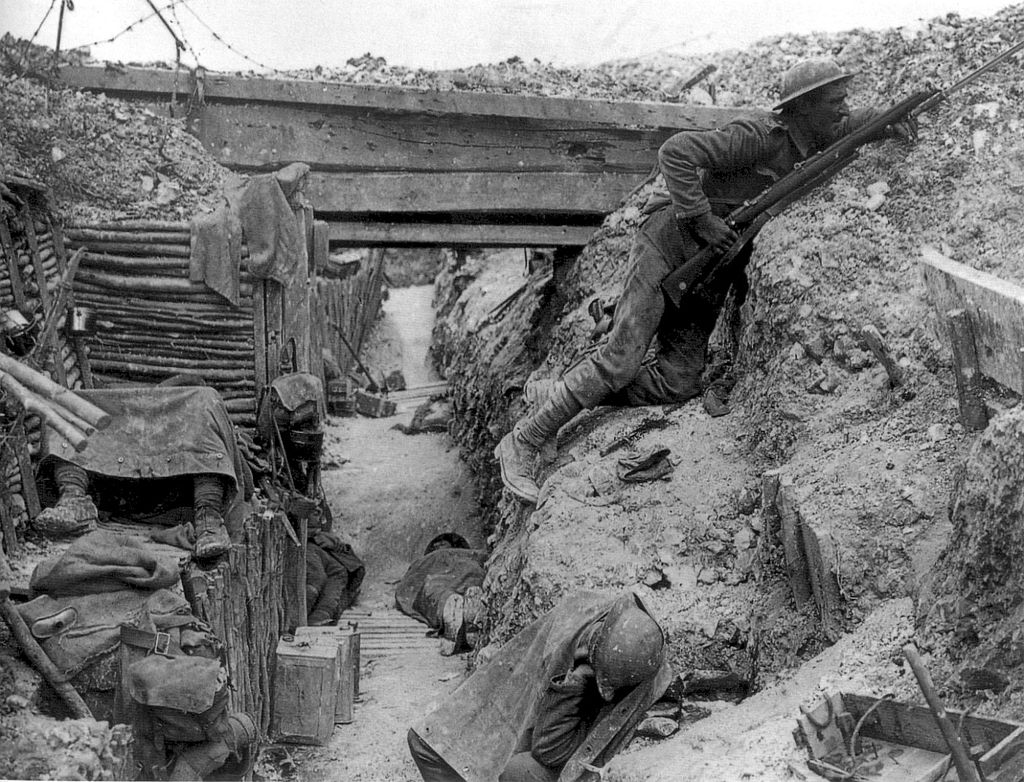Our mental image of the First World War usually excludes the army of tunnellers who toiled beneath the trenches. We picture the war in grainy, treeless black and white landscapes or stern portraits of men in heavy uniforms. Mud, trenches, heavy artillery and rows of wooden crosses come to mind, overflown by fragile biplanes and the menace of Zeppelins.
The tunnellers are forgotten. That’s because there are so few photos of a dark, dangerous activity that most contemporary soldiers preferred to ignore.

A more common view of World War I – British soldiers in a German trench during the Battle of the Somme, July 1916
The impact of tunnel warfare
On June 7 1917 the British attack on the Messines ridge, in south Belgium, began with the detonation of nineteen huge underground explosions beneath the German trenches. Each one literally ripped a hole in the German defenses, making it easier for the advancing British to achieve their objectives.
Every explosion was caused by an underground mine, created by digging a tunnel and then filling it with explosives. When it was detonated, the mine destroyed everything above it.
Around 10,000 German soldiers were never accounted for after the battle of Messines and many of them were probably killed when the mines erupted. The explosions were so loud they could be heard in London, over 130 miles away.
Unexpected and devastating, mines were impossible for the individual soldier to defend against. Because of their work, tunnellers were both respected and reviled.
Lochnagar Crater in 2012 – Created by a British mine in 1916
The difficulties of tunnel warfare
Much of the First World War involved fighting over a relatively narrow strip of land running from the Swiss border to the English Channel. Carved up into a web of trenches and dominated by machine guns, going underground was one of the few options for outflanking the enemy.
Both sides dug miles of tunnels. They started from behind their own lines, cut through the rock below no man’s land and ended, or even emerged, below or near the enemy trench.
Sometimes rival groups of tunnellers met, as their paths collided. Short, sharp encounters followed, out of sight, which usually ended in one side blowing up the tunnel. Some of those who fell remain entombed in the passages they helped construct.
The tunnellers biggest enemy was carbon monoxide, the silent killer that also stalked the coal mines where so many had worked before military service. The canary is one of the least remembered of the animals that served the British army, but many died as a primitive, but effective, method of detecting gas.
One of the many tunnels under Vimy Ridge
The First World War tunnels today
Sections of tunnel are open to the public at Vimy Ridge in France, where the geology made tunneling easy and prolific. While many passages stretch out across the battlefield towards the enemy, they were also used as accommodation and storage, and some signs of these uses still remain.
In 2011 a major project began to excavate part of the Somme battlefield, at La Boisselle in France. This was one of the most tunneled areas during the First World War and the site is within a stone’s throw of Lochnagar Crater, a deep hole blown in the earth by a mine in 1916 and still very visible today.
The British created twenty-one mines at Messines in 1917 but only detonated nineteen, because the others were outside the area of battle. The locations of the remaining two mines were lost until, in 1955, one went off during a thunderstorm. Fortunately, no one was hurt. But one mine, with the power to gouge a hole in the Flanders countryside, remains undiscovered to this day.
By Andrew Knowles
This article originally appeared on Andrew’s site infamousarmy.com, an excellent personal research blog on British military history from 1789 to 1945. Click here to see the site.
For more updates on our articles on British and international history, why not like us on Facebook? Click here!
References:
- The La Boisselle Study Group: http://www.laboisselleproject.com/
- The Tunnellers Memorial: www.tunnellersmemorial.com
- WW1 underground: Unearthing the hidden tunnel war: http://www.bbc.co.uk/news/magazine-13630203
